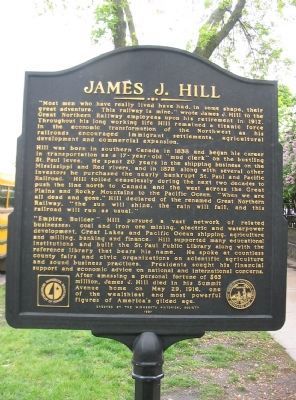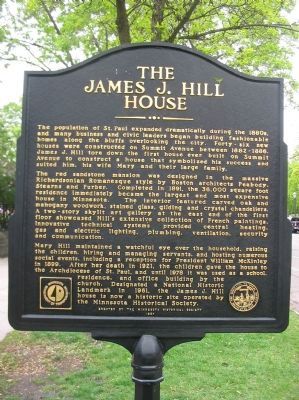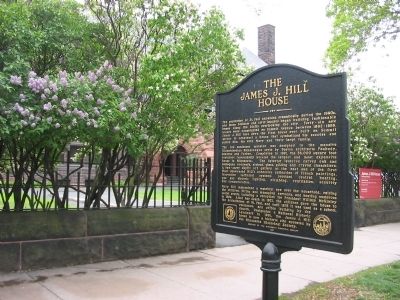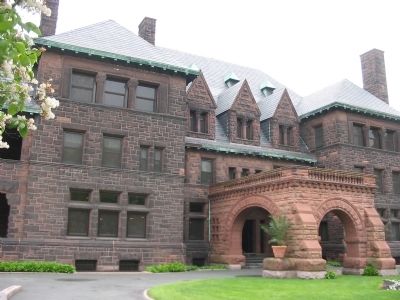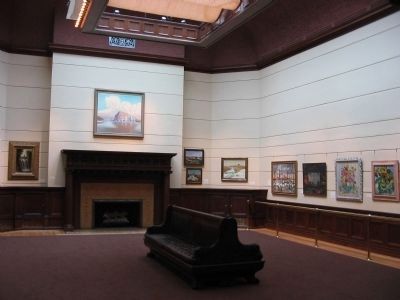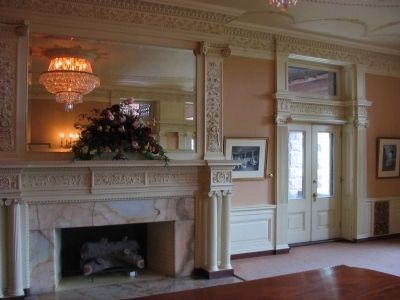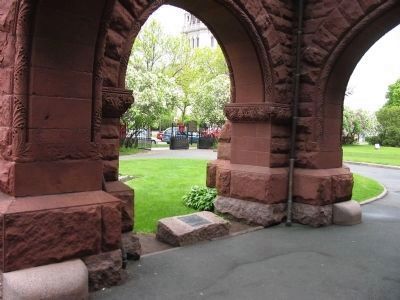Cathedral Hill in Saint Paul in Ramsey County, Minnesota — The American Midwest (Upper Plains)
James J. Hill / The James J. Hill House
James J. Hill
"Most men who have really lived here have had, in some shape, their great adventure. This railway is mine," wrote James J. Hill to the Great Northern Railway employees upon his retirement in 1912. Throughout his long working life Hill remained a titanic force in the economic transformation of the Northwest as his railroads encouraged immigrant settlements, agricultural development and commercial expansion.
Hill was born in southern Canada in 1838 and began his career in transportation as a 17-year-old "mud clerk" on the bustling St. Paul levee. He spent 20 years in the shipping business on the Mississippi and Red rivers, and in 1878 along with several other investors he purchased the nearly bankrupt St. Paul and Pacific Railroad. Hill toiled ceaselessly during the next two decades to push the line north to Canada and west across the Great Plains and Rocky Mountains to the Pacific Ocean. "When we are all dead and gone," Hill declared of the renamed Great Northern Railway, "the sun will shine, the rain will fall, and this railroad will run as usual."
"Empire Builder" Hill pursued a vast network of related businesses: coal and iron ore mining, electric and waterpower development, Great Lakes and Pacific Ocean shipping, agriculture and milling, banking and finance. Hill supported many educational institutions and built the St. Paul Public Library along with the reference library that bears his name. He spoke at countless county fairs and civic organizations on scientific agriculture and sound business practices. Presidents sought his financial support and economic advice on national and international concerns. After amassing a personal fortune of $63 million, James J. Hill died in his Summit Avenue home on May 29, 1916, one of the wealthiest and most powerful figures of America's gilded age.
The James J. Hill House
The population of St. Paul expanded dramatically during the 1880s, and many business and civic leaders began building fashionable homes along the bluffs overlooking the city. Forty-six new houses were constructed on Summit Avenue between 1882-1886. James J. Hill tore down the first house ever built on Summit Avenue to construct a house that symbolized his success and suited him, his wife Mary, and their large family.
The red sandstone mansion was designed in the massive Richardsonian Romanesque style by Boston architects Peabody, Stearns and Furber. Completed in 1891, the 36,000 square foot residence immediately became the largest and most expensive house in Minnesota. The interior featured carved oak and mahogany woodwork, stained glass, gilding and crystal chandeliers. A two-story skylit art gallery at the east end of the first floor showcased Hill's extensive collection of French paintings. Innovative technical systems provided central heating, gas and electric lighting, plumbing, ventilation, security and communication.
Mary Hill maintained a watchful eye over the household, raising the children, hiring and managing servants, and hosting numerous social events, including a reception for President William McKinley in 1899. After her death in 1921, the children gave the house to the Archdiocese of St. Paul, and until 1978 it was used as a school, residence, and office building by the church. Designated a National Historic Landmark in 1961, the James J. Hill house is now a historic site operated by the Minnesota Historical Society.
Erected 1997 by Minnesota Historical Society.
Topics and series. This historical marker is listed in these topic lists: Architecture • Industry & Commerce • Railroads & Streetcars • Settlements & Settlers. In addition, it is included in the Former U.S. Presidents: #25 William McKinley, the Minnesota Historical Society, and the National Historic Landmarks series lists. A significant historical month for this entry is May 1919.
Location. 44° 56.722′ N, 93° 6.547′ W. Marker is in Saint Paul, Minnesota, in Ramsey County. It is in Cathedral Hill. Marker is on Summit Avenue, 0.1 miles south of Selby Avenue, on the left when traveling south. Touch for map. Marker is at or near this postal address: 240 Summit Avenue, Saint Paul MN 55102, United States of America. Touch for directions.
Other nearby markers. At least 8 other markers are within walking distance of this marker. Summit–Selby Neighborhood (about 300 feet away, measured in a direct line); Cathedral of Saint Paul Cornerstone (about 700 feet away); Cathedral of Saint Paul (about 700 feet away); Site of First School Patrol Crossing in the World (about 800 feet away); St. Paul Civil War Memorial (approx. 0.2 miles away); Freedom House Station 51 (approx. 0.3 miles away); Thomas Cochran Park (approx. 0.4 miles away); Alexander Ramsey House (approx. 0.4 miles away). Touch for a list and map of all markers in Saint Paul.
Also see . . .
1. James Jerome Hill. Wikipedia entry. (Submitted on June 3, 2010.)
2. James J. Hill House. Minnesota Historical Society Website. (Submitted on June 3, 2010.)
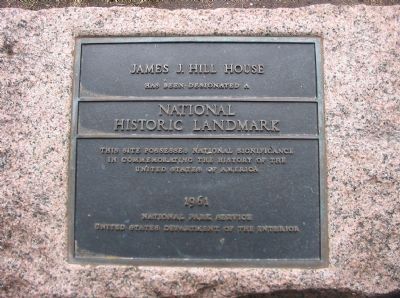
Photographed By Keith L, May 12, 2010
8. National Historic Landmark Marker
James J. Hill House has been designated a National Historic Landmark. This site possesses National significance in commemorating the history of the United States of America. 1961, National Park Service, United States Department of the Interior.
Credits. This page was last revised on August 29, 2023. It was originally submitted on June 3, 2010, by Keith L of Wisconsin Rapids, Wisconsin. This page has been viewed 2,141 times since then and 40 times this year. Last updated on August 27, 2023, by McGhiever of Minneapolis, Minnesota. Photos: 1, 2, 3, 4, 5, 6, 7, 8. submitted on June 3, 2010, by Keith L of Wisconsin Rapids, Wisconsin. • J. Makali Bruton was the editor who published this page.
